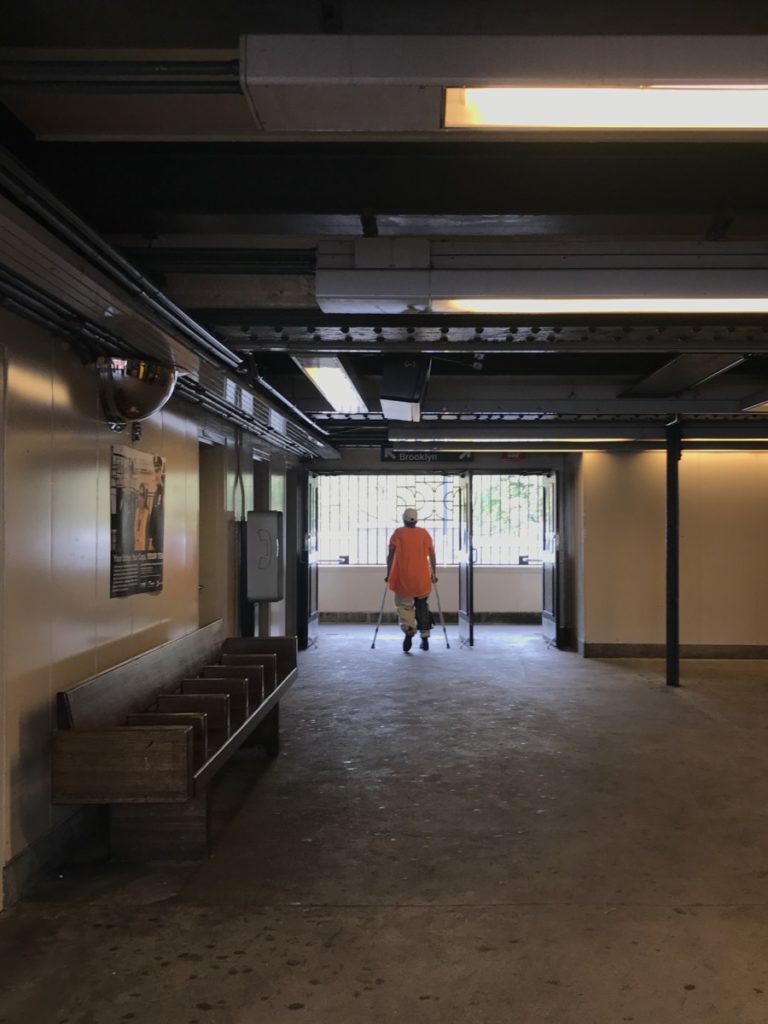
On a Wednesday afternoon, a woman wearing glasses and holding a cane struggled up the steps of the elevated Morris Heights Mt. Eden Ave. 4 train platform. Just ahead was her 9-year-old daughter, who heaved a huge empty metal shopping cart slowly up each step. Sweat rolled down her face.
“Come on!” the daughter shouted to herself.
Both Marisol Rivera and her daughter stopped frequently for breaths.
This is the daily reality of getting to and from the station, which has no elevator, for Rivera.
This isn’t the only station where disabled residents of the Bronx struggle. Of the 14 subway stops on the 4 train line running through the borough, only two are accessible by wheelchair, according to a Metro Transit Authority (MTA) subway map.
Rivera, who suffered a bad fall on slippery stairs back in 2005, has since endured long-lasting pain in her lower back, hip and legs. She relies on a walking cane to support herself.
Her child assists with carrying items like a grocery cart up the dozens of steps. But she only has the strength to lift it, empty, upwards. On their way down, when the cart is full, Rivera has to lower it herself, she said.
A lack of elevators poses a problem for mothers with babies, too. Laurie Hernandez, 22, explained whenever her mother takes the train with her baby, she meets her at the station to help carry the stroller, sometimes multiple times a day.
Leonara Delmoral, 57, is a transplant patient who relies on a walking cane. In the 20 years she has lived in her neighborhood, Mt. Eden Ave. and other stations in the Bronx have not been accessible.
“It’s not fair. It’s two flights going up to the third floor, and then when you get in, you gotta walk upstairs, too… If you’re in a wheelchair or walker, it’s very hard,” she said.
As of last Friday, the MTA listed 35 stations as having at least one elevator or escalator out of service. Two stations had their only elevators out of service.
Last year, the city approved rezoning plans that are expected to increase the population of University Heights, according to the area’s community board spokesperson Remi Bola. According to Bola, University Heights’s Community Board 5 has redoubled pressure on the MTA since then, as well as the Department of Transportation (DOT) and local elected officials to add elevators at Burnside Ave. on the 4 line. But the DOT, which is in charge of issuing permits related to construction affecting sidewalks state-wide, denied the request to install elevators at Burnside Ave.
“That proposal–they did not even let it see the light of the day,” Bola said. “We need infrastructure to be able to support [the rising population].”
Assemblyman Pichardo, of District 86, works with Rider’s Alliance, a nonprofit organization that lobbies for better transportation and riders’ rights, to increase community engagement and government awareness.
“Transportation and wheelchair accessibility is a huge problem in the Bronx, especially on the 4 line,” he wrote in a statement. “It makes it nearly impossible for handicapped individuals to have proper access.”
While Pichardo is not aware of any current legislative proposals in the Assembly aimed at resolving the issue, he said he is open to them.
As alternative handicap transportation, the MTA offers its private cab service, Access-A-Ride. But it requires ordering a day in advance, providing specific times and locations and is slower than a train.
Delmoral said she never applied for Access-A-Ride because she’d seen first-hand, the extreme wait times while working at a private doctor’s office in Manhattan.
“In my experience with Access-A-Ride, you’ll be stuck there waiting the whole day,” she said.
As soon as a patient was dropped off at her office by the service, Delmoral knew to call Access-A-Ride immediately to schedule the patient’s ride home. But even then, the patient would be seen by the doctor well before the service arrived to take them home, according to Delmoral.
Last spring, MTA President Andy Byford launched an initiative called Fast Forward, which featured proposals ranging from redesigning bus routes to improving station access. New York’s transit system is the largest in North America. However, only a quarter of its 472 stations are wheelchair accessible. The MTA released a proposal on Monday with plans to install new elevators or escalators at up to 66 stations within the next five years.
But for Rivera, Delmoral and others like them, the planned changes can’t come soon enough. In the meantime, they must resort to what little is available.
“We do what we got to do,” Rivera said.





